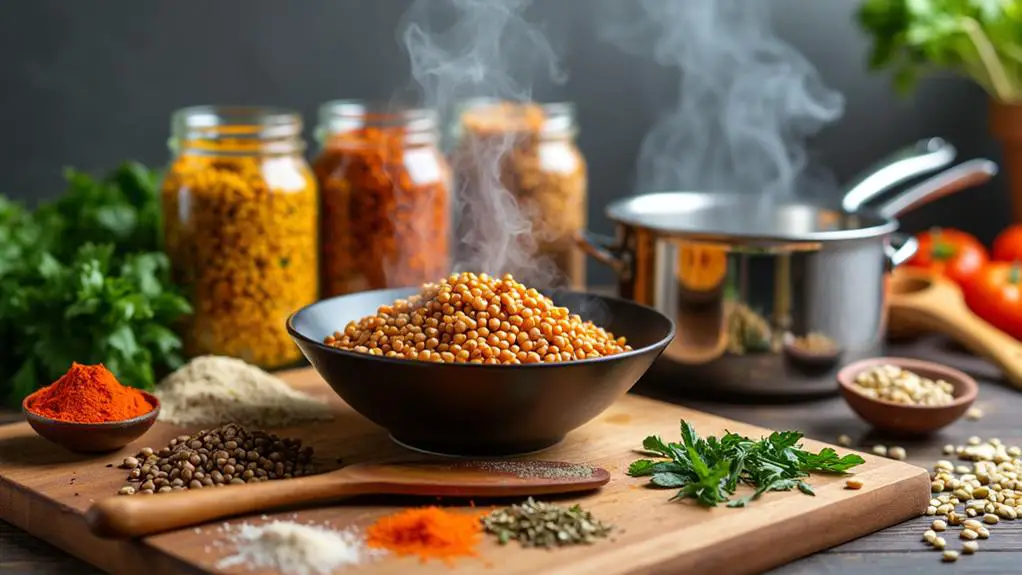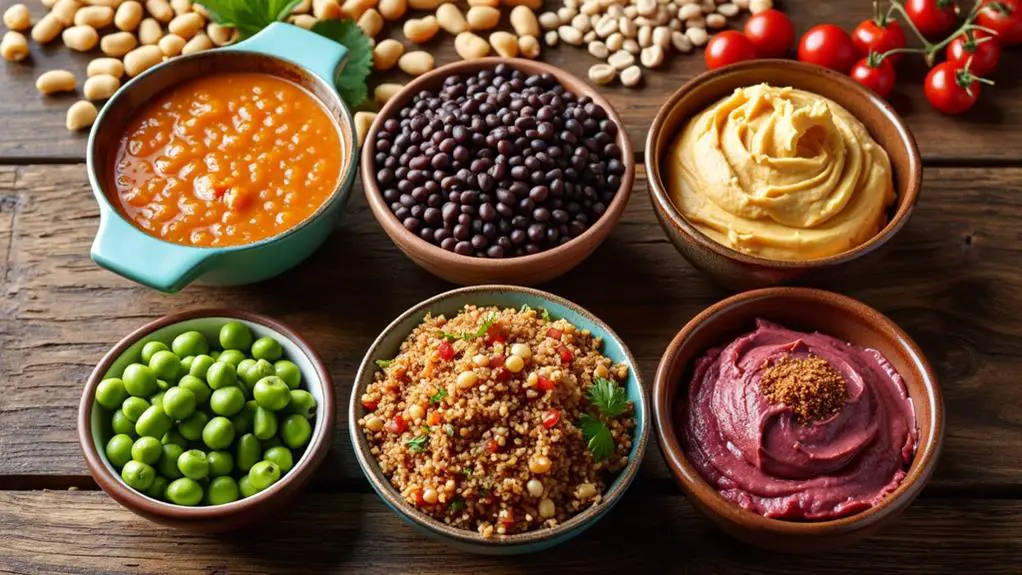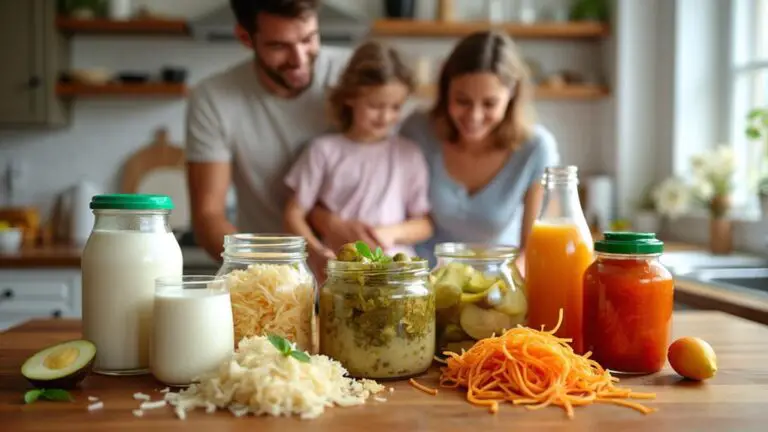Exploring Different Types of Legumes: A Protein-Packed Family Adventure
Set off on a protein-packed family adventure by exploring the diverse world of legumes. You'll discover a variety of beans, lentils, peas, and chickpeas, each offering unique flavors and textures. These nutritional powerhouses are rich in protein, fiber, and essential nutrients, making them perfect for healthy family meals. Learn to cook legumes using various techniques, from boiling to roasting, and try out family-friendly recipes like colorful hummus platters or hearty lentil tacos. Experiment with global culinary traditions that showcase legumes, and consider growing your own at home. By incorporating these versatile ingredients into your diet, you'll reveal a world of tasty, nutritious possibilities for your family's culinary journey.
Key Takeaways
- Legumes are a diverse family of plants including beans, lentils, peas, chickpeas, and soybeans, offering high protein content.
- Regular consumption of legumes supports heart health, lowers blood pressure, and reduces the risk of chronic diseases.
- Cooking techniques for legumes include boiling, pressure cooking, slow cooking, steaming, and roasting, with preparation often involving soaking.
- Family-friendly legume recipes range from colorful hummus platters to hearty lentil tacos and protein-rich black bean brownies.
- Growing legumes at home is sustainable, improves soil health through nitrogen fixation, and typically yields harvests within 50-70 days.
The World of Legumes
Often overlooked, legumes are nutritional powerhouses that belong to the diverse Fabaceae family.
You'll find a wide variety of edible seeds in this group, including beans like black and kidney beans, lentils, peas, and chickpeas.
These protein-packed gems are known for their impressive nutrient profile, offering substantial amounts of dietary fiber, iron, and folate in just a half-cup serving.
As a versatile protein source, legumes feature prominently in cuisines worldwide.
You can enjoy them in dishes like hummus made from chickpeas or lentil tacos.
Soybeans stand out as the protein champion among legumes, providing about 63% of your daily value per cup.
Nutritional Powerhouses
You'll find a treasure trove of protein in legumes, with soybeans leading the pack at 63% of your daily value per cup.
As you explore different varieties, you'll discover that chickpeas and lentils offer about 20% of your daily fiber needs in just a half-cup serving.
These nutritional powerhouses are also packed with essential vitamins and minerals like folate, potassium, and iron, contributing to your overall health and well-being.
Protein-Rich Bean Varieties
Diving into the world of protein-rich legumes reveals an array of nutritional powerhouses.
You'll find soybeans, including edamame, topping the list with a whopping 63% of your daily protein needs per cup. Tempeh, made from fermented soybeans, packs an even bigger punch with 87% of your daily value.
Don't overlook lupin beans, offering 67% of your protein needs, or adzuki beans, which provide 52%.
These protein-packed legumes not only support your health but also offer versatility in the kitchen. Imagine:
- Crispy tempeh bacon strips sizzling in a pan
- Steaming edamame pods sprinkled with sea salt
- Creamy lupin bean dip with colorful veggie sticks
- Sweet adzuki bean paste nestled in a warm pastry
Chickpeas, with 29% of your daily protein, round out this nutrient-dense family, offering both protein and dietary fiber for a balanced diet.
Essential Nutrients Breakdown
Nutritional powerhouses, legumes pack a punch far beyond their protein content. You'll find these versatile foods are rich in essential nutrients that support your overall health.
A half-cup serving of legumes provides about 20% of your daily dietary fiber needs, aiding digestion and blood sugar regulation. They're also excellent sources of folate, with lentils offering a whopping 90% of your daily value per cup. This nutrient is vital for cell creation and anemia prevention.
Legumes contribute to heart health by being low in saturated fat and cholesterol while providing significant amounts of iron and potassium.
By incorporating these protein-rich foods into your diet regularly, you're not only fueling your body with high-quality protein but also supporting lower blood pressure and reducing your risk of chronic diseases.
It's clear that legumes are true nutritional all-stars.
Cooking Techniques for Legumes

You'll find that preparing legumes can be simpler than you might think.
Start by soaking dried legumes for 4-8 hours to reduce cooking time and improve digestibility, or opt for canned varieties for instant use.
Cooking times vary widely, with lentils typically ready in 5-25 minutes, while larger beans may take longer, depending on your chosen method of boiling, pressure cooking, or slow cooking.
Soaking and Prep Methods
Getting the most out of your legumes starts with proper preparation. Soaking dried beans for 4-8 hours can considerably reduce cooking time and enhance digestibility.
If you're short on time, canned legumes are a convenient alternative, but don't forget to rinse them to reduce sodium content.
When cooking legumes, consider these methods:
- Boiling: Simmer for 30-60 minutes
- Pressure cooking: Quick and efficient
- Slow cooking: Perfect for busy schedules
- Discarding soaking water: Reduces gas-producing compounds
To minimize digestive discomfort, gradually increase your fiber intake by introducing legumes into your diet slowly.
This allows your system to adjust to the higher fiber content. Remember, proper soaking and cooking methods are key to revealing the full nutritional potential of these protein-packed powerhouses.
Cooking Time Variations
Now that you've mastered the art of prepping legumes, let's explore the various cooking times and techniques.
Different legumes require different cooking durations. Red lentils cook quickly in 5-7 minutes, while green lentils take 15-20 minutes, and brown lentils need 20-25 minutes. Dried beans, once soaked, typically take 1-2 hours to boil.
For a time-saving option, pressure cooking can reduce cooking time to 10-30 minutes for dried beans. If you prefer a hands-off approach, slow cooking offers tender results in 6-8 hours on low heat or 3-4 hours on high.
For ultimate convenience, canned beans are pre-cooked and ready to use after a quick rinse. Remember, cooking times may vary slightly depending on the specific variety and desired tenderness.
Family-Friendly Legume Recipes
Countless family-friendly legume recipes can transform these protein-packed powerhouses into dishes your whole family will love.
From lentil tacos to chickpea curry, legumes offer a hearty source of protein and fiber that's sure to satisfy. You'll even find surprising ways to incorporate them into desserts, like black bean brownies that are rich in protein and low in fat.
Experiment with these family-friendly legume ideas:
- Create a colorful hummus platter with various flavors like roasted red pepper and garlic.
- Simmer a comforting minestrone or split pea soup packed with nutritious legumes.
- Toss crisped chickpeas into salads for a crunchy protein boost.
- Whip up a batch of protein-rich black bean brownies for a guilt-free treat.
These recipes will help you introduce legumes into your family's diet in fun and delicious ways.
Global Legume Culinary Traditions

Throughout history, legumes have played a starring role in global cuisines, showcasing their versatility and nutritional value across cultures.
You'll find them in Indian dal, Mexican refried beans, and Middle Eastern hummus, each dish highlighting their protein-rich nature. In Mediterranean diets, lentils and chickpeas are daily staples, providing 8-23 grams of protein and contributing to heart health.
African cuisines feature black-eyed peas and cowpeas, essential for food security. South American dishes like feijoada showcase legumes' cultural significance as a primary protein source.
In Asia, you'll encounter fermented soybeans in miso soup and adzuki bean desserts. These global culinary traditions not only demonstrate legumes' adaptability but also their importance in providing essential nutrients and dietary fiber.
Growing Legumes at Home
After exploring the global culinary traditions of legumes, you might be inspired to bring these nutritious plants closer to home.
Growing your own legumes is surprisingly easy and rewarding. These protein-rich plants thrive in well-drained soil and full sun, making them perfect for containers or garden beds.
You'll enjoy:
- Quick results – many varieties mature in just 50-70 days
- Multiple harvests in a single season
- Improved soil fertility through nitrogen fixation
- Low-maintenance gardening suitable for beginners
Start by sowing seeds directly after the last frost. As your homegrown legumes flourish, you'll witness their soil-enriching properties firsthand.
When it's time for harvesting, pick snap peas and green beans young and tender. For dry beans, wait until pods are fully mature. With minimal effort, you'll soon be enjoying fresh, nutritious legumes straight from your garden.
Conclusion
As you close the book on your legume journey, remember that these humble seeds symbolize growth and nourishment. You've planted the knowledge, tended it with curiosity, and now it's time to reap the rewards. Let legumes be the pillars of your family's health, supporting you like sturdy bean poles. They're more than just food; they're a gateway to global flavors and sustainable living. Embrace the legume lifestyle, and watch your family thrive.







